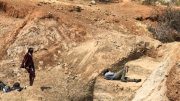When was the last time you had to unpack a crate full of squashed baby sea turtles and their eggs that were smuggled across international borders in someone’s luggage? Do you think you could do it every day, and see other animals similarly crushed and abused, without eventually having a nervous breakdown? Meet Edal Jones — she’s a federal wildlife officer who is on stress leave from her inspection job at the airport, and a main character in Fauna, the latest work by Torontonian Alissa York.
While biking aimlessly around the city early one morning, Edal spots a young girl — Lily — picking up birds that have knocked themselves out by flying into towers downtown. Being on the lam, Lily won’t explain to this official-type (not in uniform) woman that she’s only trying to save some sparrows, so instead Lily bolts. The pursuit leads Edal to an old car-smashing business, which acts as the HQ for the town’s vigilante animal-saving team — Lily and her sidekick, the massive dog named Billy; Stephen, the PTSD-suffering war vet; and Guy, the Hannibal Smith of this ragtag bunch of misfits. What none of these folks know yet is that they’re about to meet a trusted ally, and a terrible foe.
Lily, ever the one to be bringing home new friends of fowl and human varieties, meets Kate, a veterinary technician. Kate blows Lily’s mind by explaining her occupation as “physio for dogs,” and by subsequently being really comfortable with Billy. As one love blossoms, elsewhere a rivalry begins.
A poster catches Stephen’s eye while he’s out for a morning stroll. This poster is one of many along his route, advertising a blog written by “Coyote Cop,” a loner with an irrational hatred of coyotes. Stephen tries to reason with him by ripping down his posters and posting in the comment section of the online manifesto, but to no avail. Coyote Cop’s desire to destroy will not be so easily quashed, and his madness escalates.
York’s work reads as easily as a conversation with an old friend. The seemingly random but specific facts supplied about the animals in the story will pique the interest of those of us with a passing interest in animals and nature, and Fauna’s narrative of man vs. nature provides shape and depth to a plot that could otherwise seem drawn-out and uneventful.
While Kate ponders the commonalities of the pets she rehabilitates and the people who bring them in; as Stephen and Coyote Cop discuss their relative beliefs about the morality of nature and animals — asking questions about how different we humans really are from coyotes, and whether we even have the right to determine what has the right to live in a given area — one can draw parallels between the animals these people are trying to save, and the people they will inevitably save as well. Which will heal first: a human’s psyche, or a wild hawk’s wing? You can never be sure until they leave the nest and try to fly.



